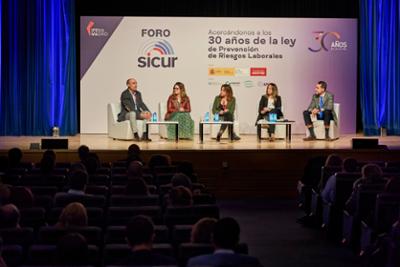

FORO SICUR 2024 highlights the importance of sustainability in firefighting
FORO SICUR is complemented by SICUR CYBER and EXO CORNER presentations.
Experts warn of the challenge of façades in high-rise buildings. Non-combustible products provide additional time for evacuation. FORO SICUR is taking place during the International Security Exhibition, organised by IFEMA MADRID from 27 February to 1 March.
During FORO SICUR, experts emphasised the significance of sustainability in extinguishing fires and raised concerns about the difficulties posed by high-rise building façades. “In these types of buildings, it is crucial to have additional time for evacuation. This can be achieved by using non-combustible products and solutions," they said. FORO SICUR 2024 will take place during SICUR 2024, the International Security Exhibition, organised by IFEMA MADRID from 27 February to 1 March.
During the 'Sustainability and Fire’ conference, experts from CEPREVEN, TECNIFUEGO, APICI, ASELF, and APTB discussed the topic of photovoltaic generation, lithium-ion batteries, and high-rise building façades. In the first instance, Carlos Chicharro, Director of the Active Protection Area at TECNIFUEGO, explained the risks associated with photovoltaic installations on the roofs of industrial buildings. He noted that in Spain, PV self-consumption increased from 22 MW to 2,508 MW between 2014 and 2022. Additionally, an international study found that over 75% of PV fires happened on building roofs. Eduardo Garcia Mozos, the first vice-president of APICI, expressed concern about the risks associated with photovoltaic installations in the insurance sector. He emphasised the need for preventive measures to control their accident rate.
Antonio Tortosa, vice-president of TECNIFUEGO, warned that there is still much to learn about the risks of lithium-ion batteries. Elisa Ruiz Germés, Project Manager at Cepretec, explained the new tests for extinguishing electric vehicles in garages. She highlighted that “lithium-ion batteries fail and burn differently from vehicles with internal combustion engines, making them more challenging to extinguish.” Aurelio Rojo, the honorary president of APICI, mentioned fires in electric bus and train batteries.
Regarding the challenge of façades in high-rise buildings, Albert Grau, Director of the Passive Protection Area at TECNIFUEGO, stated that “in this type of building, having additional time for evacuation is crucial, and this can be achieved through the use of non-combustible products and solutions.” In fact, “since 2018 TECNIFUEGO has been advocating for more ambitious regulations for products used in this type of building.”
During another session at FORO SICUR, Alfonso Díez, coordinator of TECNIFUEGO's Passive Protection Products Manufacturers' Sector Committee, explained the fundamentals of passive protection product sheets. He emphasised that “these products, solutions or systems prevent the collapse of buildings and/or the spread of gases and flames from one fire sector to another.”
Meetings on Security
In the field of Security, FORO SICUR hosted a meeting on the security management of cultural heritage. Ricardo Sanz Marcos, from ASIS International, emphasised “the crucial role of security in this field”. Blanca Mora, head of the Restoration and Cultural Heritage Service of Madrid City Council, pointed out that Madrid has “1,568 monuments on public roads, which pose a significant security challenge.” Cristina Escudero, the coordinator of the Castilla y León Cultural Heritage Risk and Emergency Management Unit, stated that the region has 11 world heritage sites and 2,564 sites of cultural interest. She also mentioned that these sites are at risk “due to climate change and tourism.” Domingo Gómez, the head of Metro de Madrid's Security Department, mentioned the company's “five small museums”, which are safeguarded “by security personnel and other systems.”
The Spanish delegation participated in Horizon Europe’s Cluster 3: Civil security for society, part of the European Union's R&D&I framework programme. Within SICUR’s framework, they carried out several activities. Representatives from the Community for European Research and Innovation for Security (CERIS) discussed disaster-resilient societies and how to cope with high-impact, low-probability events that disrupt our societies. Philippe Quevauviller of the European Commission chaired the session. Marina Martínez of CDTI-SOST analysed extreme weather events and the response of natural chapters.
One of the conferences focused on the AES's 43-year history of energising the private security industry. The presentation was given by AES President Iñigo Ugalde and covered topics such as the interpretation guide for grade III and IV installations, as well as the revision of cash container seals in obligatory establishments.
FORO SICUR hosted the presentation of the III Report on the status of women in public and private security. Ana Borredá, treasurer of the Observatorio Mujeres de la Seguridad [Women in Security Observator in English], revealed that in 2023, women made up only 15.16% of the private security sector, compared to 85.84% being made up of men. However, the trend is positive as more women are joining. The S2R-2024 Congress, focused on Safety, Security and Resilience Research in Europe, was held as part of the SICUR event.
Occupational Safety Conferences
FORO SICUR hosts various meetings and presentations on Occupational Safety. Mapfre Foundation and INSST discussed the 30-year validity of the Law on Occupational Risk Prevention in a conference. Experts from the Labour Inspectorate, the Regional Institute, the Prosecutor for Safety and Health at Work, social partners from CEOE, CEPYME, UGT and Workers' Committees, and the prevention services and companies ANEPA, ASPREM, AESPLA, PRL PREVENCIÓN and AMAT also participated.
According to Carlos Arranz, director of the INSST, the incidence rates of occupational accidents have decreased in all sectors except agriculture between 1995 and 2022. Additionally, mortality rates have decreased by approximately 60%. However, from 2012 to 2024, the decrease in the accident rate has stagnated. Therefore, measures must be taken to resume the downward trend.” According to Pablo Orofino Vega, the deputy technical director of the National Institute for Safety and Health at Work, the law on occupational risk prevention has “introduced significant improvements and provided flexibility to address issues”. Irene Marín Luengo, Deputy Director General for Coordinating the Inspection of the Labour Relations System at the Ministry for Labour and Social Economy, emphasised the importance of “harmonising with the European framework”.
On 1 March, the FORO SICUR programme will end along with the show. Presentations will be given by CEUSS on security video cameras and by the UME on their new drone unit, UDRUME, and its operation during the earthquake in Türkiye in February 2023, presented by Lieutenant Colonel José Luis Jiménez Borraz.
In addition to the FORO SICUR, the International Security Exhibition will also host SICUR CYBER, a space dedicated to cybersecurity, organised in collaboration with Seguritecnia and Red Seguridad, and the EXO CORNER Speaker's Corner.
This content area complements the exhibition area in Halls 4, 6, 8 and 10, where leading companies and associations from the Fire and Emergency Safety and Occupational Security sectors showcase their innovations in occupational safety and providing exciting live demonstrations.





